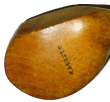
|
Registration Edit profile catalogue auction shopping cart shipping history makers search faq news links about contact |

Clubmakers
R B Wilson
St Andrews/Hamburg/NYC
 Robert Black "Buff" Wilson was born in Anstruther in 1869 and there probably knew Robert Condie from whom he bought many iron heads when they both later moved to St Andrews. Wilson spent a year clubmaking with Old Tom Morris, in 1887 and later worked with Jamie Anderson. In addition to his clubmaking skills he was a fine golfer, wining a St Andrews tournament which had Andrew Kirkaldy, his brother Hugh and Davie Ayton in the field. He and Douglas Rolland triumphed over Hugh Kirkaldy and Jack White, both Open Champions, in a “purse” match at East Grinstead. In 1888, took up the position of professional/greenkeeper at Minchinhampton in Gloucestershire where he first had to lay out the course. (This course is famous for the woodcut of the lady golfer by Lucien Davis in 1890).
Robert Black "Buff" Wilson was born in Anstruther in 1869 and there probably knew Robert Condie from whom he bought many iron heads when they both later moved to St Andrews. Wilson spent a year clubmaking with Old Tom Morris, in 1887 and later worked with Jamie Anderson. In addition to his clubmaking skills he was a fine golfer, wining a St Andrews tournament which had Andrew Kirkaldy, his brother Hugh and Davie Ayton in the field. He and Douglas Rolland triumphed over Hugh Kirkaldy and Jack White, both Open Champions, in a “purse” match at East Grinstead. In 1888, took up the position of professional/greenkeeper at Minchinhampton in Gloucestershire where he first had to lay out the course. (This course is famous for the woodcut of the lady golfer by Lucien Davis in 1890).Short spells as professional at Sheffield, Sidcup and Beckenham followed, before he sailed to the US in 1896 to take up the post of professional at Shinnecock Hills, Long Island. He sailed from Southampton aboard the Paris on 2 May 1896 arriving in New York exactly a week later. Interestingly on the ship’s manifest he is described not as a professional golfer but as a merchant. The second US Open was played at Shiinecock Hills that year and Wilson finished 9th behind James Foulis. The April 1897 issue of Golf, published in New York, carries an advertisement from him, 'R B Wilson, late of Shinnecock Hills Golf Club, is open for an engagement. Highest references.' He spent the following season as the second professional at the Huntingdon Valley Country Club in Rydal, PA, founded the previous year.
He patented a mashie-cleek for approach shots and sold 1200 of them in 1898. A press report on him while he was home in St Andrews for the winter of 1901-2 mentioned also his patented Daisy mashie and that he had three patents for putters going through registration: the “1000” with holes cut through at toe and heel leaving a central corrugated striking area; another corrugated putter, the “A1” with a goose-neck and the “100” putter, designed for seaside grass, with a depth of face of only one inch with a lie back and heavy and broad rest.
He spent several summers as pro/instructor at Lakewood and Deal, NJ, and in Connecticut, but always returned to St Andrews for the winter months. He used the time there to make clubs which he exported to the US. In 1905 he accepted the position of professional at the Wentorf Reinbek club in Germany but returned to St Andrews again, in semi-retirement, in 1910.
He then ran an interestingly mixed shop in St Andrews, ‘newsagent, stationer, tobacconist and golf clubmaker’. To those who long for the ‘good old days’ of St Andrews and wartime camaraderie, Wilson opening his shop on Christmas morning, 1940, was hit over the head by a man standing in the shadows who stole a bag containing £8 or £9 and left Wilson with a concussion.
Despite the large numbers of clubs he exported to the US between 1895 and 1905, his earlier irons, almost all forged by Condie, and. of course, the unusual patented ones, are very collectible.
My thanks to Andrew Isztwan of the Heritage Committee of the Huntingdon Valley CC for making me aware of that connection.
![]() Search the catalogue for
clubs by this maker
Search the catalogue for
clubs by this maker
site design dmc ltd | © 2000-2024 Antique Golf Clubs from Scotland